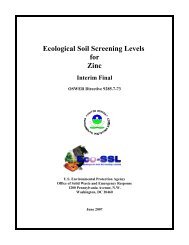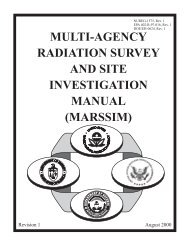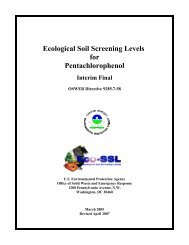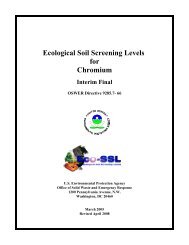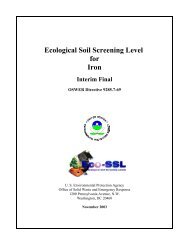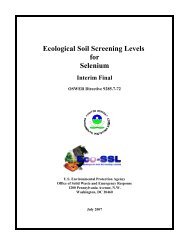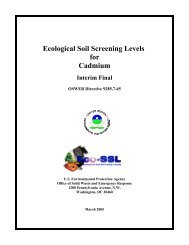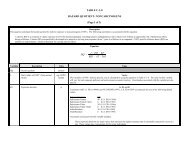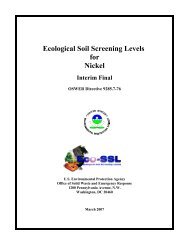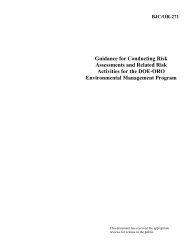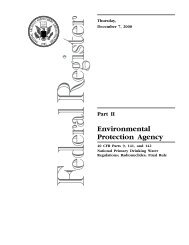Understanding Variation in Partition Coefficient, Kd, Values Volume II
Understanding Variation in Partition Coefficient, Kd, Values Volume II
Understanding Variation in Partition Coefficient, Kd, Values Volume II
Create successful ePaper yourself
Turn your PDF publications into a flip-book with our unique Google optimized e-Paper software.
FOREWORD<br />
<strong>Understand<strong>in</strong>g</strong> the long-term behavior of contam<strong>in</strong>ants <strong>in</strong> the subsurface is becom<strong>in</strong>g<br />
<strong>in</strong>creas<strong>in</strong>gly more important as the nation addresses groundwater contam<strong>in</strong>ation. Groundwater<br />
contam<strong>in</strong>ation is a national concern as about 50 percent of the United States population receives<br />
its dr<strong>in</strong>k<strong>in</strong>g water from groundwater. It is the goal of the Environmental Protection Agency<br />
(EPA) to prevent adverse effects to human health and the environment and to protect the<br />
environmental <strong>in</strong>tegrity of the nation’s groundwater.<br />
Once groundwater is contam<strong>in</strong>ated, it is important to understand how the contam<strong>in</strong>ant<br />
moves <strong>in</strong> the subsurface environment. Proper understand<strong>in</strong>g of the contam<strong>in</strong>ant fate and<br />
transport is necessary <strong>in</strong> order to characterize the risks associated with the contam<strong>in</strong>ation and to<br />
develop, when necessary, emergency or remedial action plans. The parameter known as the<br />
partition (or distribution) coefficient (K d) is one of the most important parameters used <strong>in</strong><br />
estimat<strong>in</strong>g the migration potential of contam<strong>in</strong>ants present <strong>in</strong> aqueous solutions <strong>in</strong> contact with<br />
surface, subsurface and suspended solids.<br />
This two-volume report describes: (1) the conceptualization, measurement, and use of the<br />
partition coefficient parameter; and (2) the geochemical aqueous solution and sorbent properties<br />
that are most important <strong>in</strong> controll<strong>in</strong>g adsorption/retardation behavior of selected contam<strong>in</strong>ants.<br />
<strong>Volume</strong> I of this document focuses on provid<strong>in</strong>g EPA and other environmental remediation<br />
professionals with a reasoned and documented discussion of the major issues related to the<br />
selection and measurement of the partition coefficient for a select group of contam<strong>in</strong>ants. The<br />
selected contam<strong>in</strong>ants <strong>in</strong>vestigated <strong>in</strong> this two-volume document <strong>in</strong>clude: chromium, cadmium,<br />
cesium, lead, plutonium, radon, strontium, thorium, tritium ( 3 H), and uranium. This two-volume<br />
report also addresses a void that has existed on this subject <strong>in</strong> both this Agency and <strong>in</strong> the user<br />
community.<br />
It is important to note that soil scientists and geochemists knowledgeable of sorption<br />
processes <strong>in</strong> natural environments have long known that generic or default partition coefficient<br />
values found <strong>in</strong> the literature can result <strong>in</strong> significant errors when used to predict the absolute<br />
impacts of contam<strong>in</strong>ant migration or site-remediation options. Accord<strong>in</strong>gly, one of the major<br />
recommendations of this report is that for site-specific calculations, partition coefficient values<br />
measured at site-specific conditions are absolutely essential.<br />
For those cases when the partition coefficient parameter is not or cannot be measured,<br />
<strong>Volume</strong> <strong>II</strong> of this document: (1) provides a “thumb-nail sketch” of the key geochemical<br />
processes affect<strong>in</strong>g the sorption of the selected contam<strong>in</strong>ants; (2) provides references to related<br />
key experimental and review articles for further read<strong>in</strong>g; (3) identifies the important aqueousand<br />
solid-phase parameters controll<strong>in</strong>g the sorption of these contam<strong>in</strong>ants <strong>in</strong> the subsurface<br />
environment under oxidiz<strong>in</strong>g conditions; and (4) identifies, when possible, m<strong>in</strong>imum and<br />
maximum conservative partition coefficient values for each contam<strong>in</strong>ant as a function of the key<br />
geochemical processes affect<strong>in</strong>g their sorption.<br />
iii



